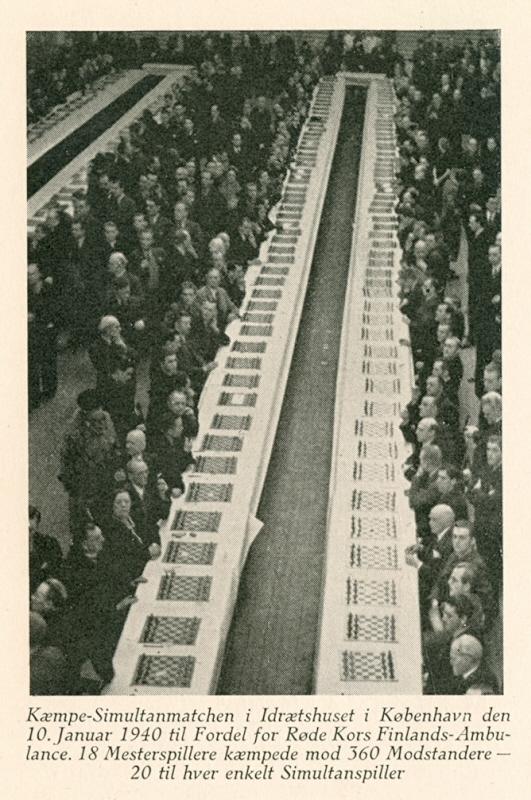
Edward Winter

From page 378 of Alt om Skak by B. Nielsen (Odense, 1943).
A paragraph from CHESS, May 1973, page 221:
‘On 21 April Jude Acers, the San Francisco master, set up a new world simultaneous record. In 13 hrs, 41 mins (giving opponents choice of colour) he played 117, winning 93 games, drawing 11 and losing 13. Several thousand turned up to watch. He earned 1,000 dollars.’
In the next issue Wolfgang Heidenfeld wrote:
‘Who sent you the piece of nonsense about the “new world simultaneous record” by the widely-unknown “master” Acers? Many years ago Hönlinger played 213, which a little later was upped to 250 by Najdorf, even if the 400 of Ståhlberg’s against consulting teams – a somewhat different type of performance – is left out of account.’
Editor’s reply: ‘Mr Acers sent it.’
(899)
From the ‘Simultaneous Display’ entry in The Encyclopedia of Chess by Harry Golombek (London, 1977 and Harmondsworth, 1981):
‘It is also reported that a certain Dr Backer played 1,000 games in San Francisco 1938 with the result +343 –138 =519.’
Golombek’s words appeared in the section on exhibitions given on a replacement basis (i.e. with new games beginning as others are completed).
Whether such a display ever occurred was a question raised in C.N. 899 by Hugh Myers (Davenport, IA, USA), who pointed out that ‘Backer’ is usually given as ‘Basker’. Our correspondent quoted from page 122 of the March 1938 BCM (of which Golombek was then the General Editor):
‘San Francisco. A certain Dr Basker has succeeded in performing the herculean task of playing 1,000 boards simultaneously. His results were (after four days’ play) 343 wins, 138 losses and 519 draws.’
The story was widely reported. For example, the following was published on page 100 of the Australasian Chess Review, 30 April 1938:
‘A certain Dr Basker, of San Francisco, is reported to have played 1,000 games simultaneously. After four days’ play, he finished up with a score of 343-137 [sic], and 519 draws. We assume that his opponents came along in relays or waves, with day and night shifts.’
Finally, from page 337 of CHESS, 14 June 1938:
‘Several magazines and journals have reported that a certain Dr Basker, of San Francisco, has played 1,000 opponents simultaneously, winning (after four days’ play) 343, drawing 519, losing 138. We believe the whole thing is a hoax.’
Does any reader know more about the affair?
(3230)
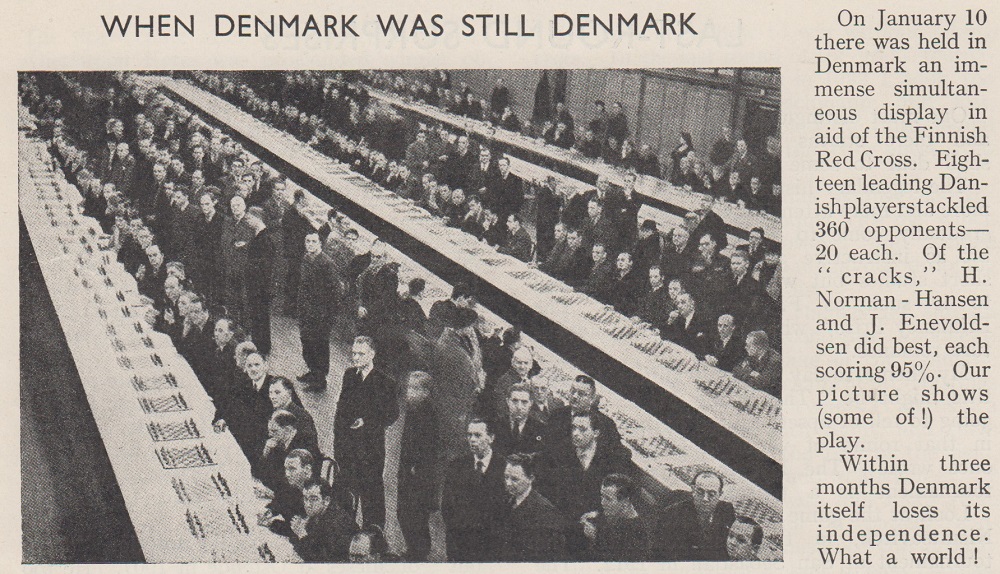
CHESS, May 1940, page 185
An observation by Irving Chernev on page 37 of the November 1953 CHESS:
‘In the New York Times for 30 October 1949 Reuben Fine reviewing The Fireside Book of Chess by Chernev and Reinfeld says at one point, “The statement that Gideon Ståhlberg holds the world’s record for simultaneous play with his 400-game exhibition at Buenos Aires in 1941 is not true because the games were played consecutively, not simultaneously.”
The authors of the book took their information from a chapter on simultaneous chess wherein the writer said, “Ståhlberg played the 400 games in Buenos Aires about 1940 in 36 hours”. The book where this chapter appeared is called Chess Marches On!. The author, Reuben Fine …’
Below is the full paragraph from Fine’s book (page 210):
‘While the average number of boards in an ordinary exhibition is between 20 and 40, the world’s record is no less than 400. We have never seen any details other than those first carried at the time: Ståhlberg played the 400 games in Buenos Aires about 1940 in 36 hours. On this side of the equator, Lilienthal holds the blue ribbon with 202 games at Madrid, about 1933. Perhaps the most remarkable qualitative achievement of all times is Capablanca’s 103 board exhibition at Cleveland in 1909, when he won 102 and drew one.’
Whether Lilienthal played 202 games ‘at Madrid, about 1933’ is open to doubt. Our own information on his largest display in Spain was given in C.N. 2949 (121 opponents in Bilbao on 11 November 1934 – see C.N. 2949 on page 177 of Chess Facts and Fables). That performance was also mentioned by Lilienthal on page 87 of his autobiographical volume Életem, a sakk (Budapest, 1985). Capablanca’s famous Cleveland display took place not in 1909 (or even ‘about’ then) but in 1922.
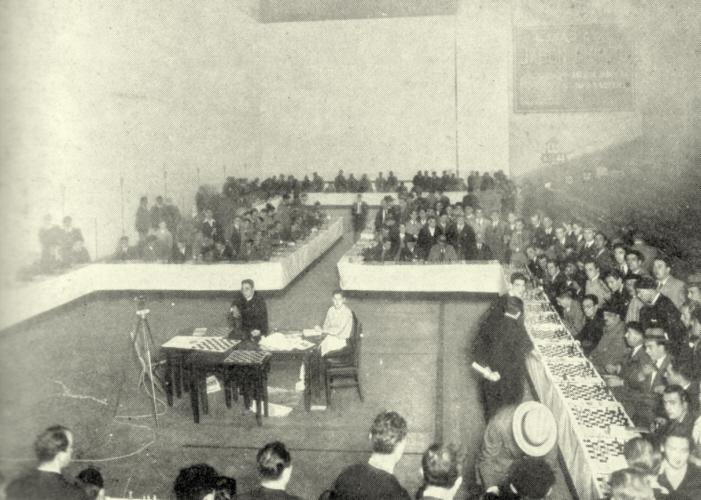
Display by A. Lilienthal, Bilbao, 1934 against 121 opponents
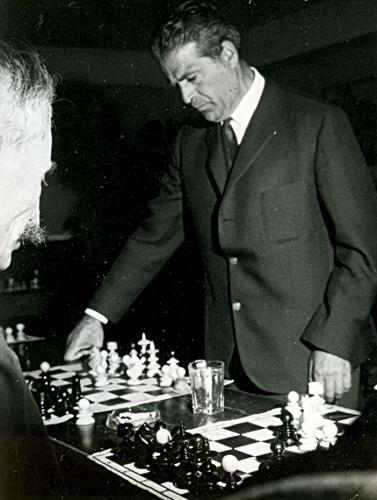
Andor Lilienthal
Reverting to Ståhlberg, we have found no report on the 400-board display in the 1941 issues of the Argentinian magazines El Ajedrez Americano and Enroque!!, although other chess periodicals of the time carried accounts, one example being the August-September 1941 Chess Review (page 156):
‘Ståhlberg breaks record. Gideon Ståhlberg, Swedish Chess Master, has broken the world’s record for the number of boards played simultaneously and time of play. In a gigantic exhibition at Buenos Aires, Ståhlberg played 400 separate games in 36 hours 5 minutes, winning 364, losing 22 and drawing 14. He started to play at 10 p.m. Friday, 29 August, finished at 10.05 a.m. Sunday, 31 August.’
What basis is there for Fine’s assertion that ‘the games were played consecutively, not simultaneously’? And are any of the game-scores extant?
(3373)
Page 183 of the June 1941 issue of El Ajedrez Americano reported that Najdorf had just given a 222-board simultaneous display in Bahía Blanca and that this figure greatly exceeded the previous record, i.e. 187 games played by Lilienthal. The Argentine magazine furthermore stated that Najdorf’s total score was 202 wins (one of them blindfold), eight losses and 12 draws in 13½ hours, whereas Lilienthal had achieved only 67%.
The obvious question is why a magazine that gave these comprehensive details about Najdorf’s ‘record-breaking’ 222-game display would have ignored, just a few months later, a 400-board exhibition, also in Argentina, by Ståhlberg. Is the explanation that those 400 games were not played simultaneously?
We also seek information on the various large displays given by Lilienthal. To quote just one example, page 178 of his book Életem, a sakk (Budapest, 1985) indicates that he played against 201 opponents in Sverdlovsk in early 1941.
Turning to older exhibitions, we can do no better than mention a few reports that come to mind, such as the following from page 133 of the January 1885 Chess Monthly:
‘On the 3rd ult. Mr. Zukertort entered his engagement of three days’ play at Newcastle-on-Tyne. The first day was devoted to simultaneous games. He played at the Art Gallery 60 games, of which he won 53, lost three and drew four. Play lasted six hours, viz., from 3.30 till 5.30, and from 6.30 till 10.30 p.m.’
C.A. Walbrodt faced 60 opponents in Berlin on 9 December 1900, scoring +49 –3 =8 (Deutsche Schachzeitung, February 1901, page 57). On 29 June 1911 Hans Fahrni played 100 games simultaneously in Munich (+ 55 –6 =39). A detailed report, under the heading ‘Ein Weltrekord im Schach’ was published, without any games, on pages 9-12 of Schachjahrbuch für 1911. I. Teil by L. Bachmann (Ansbach, 1912).
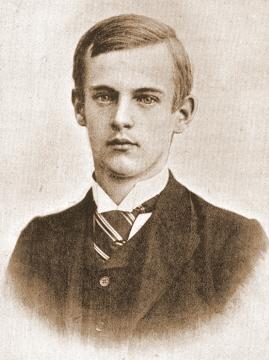
Carl August Walbrodt
Over the next decade or so, the record was progressively improved upon by Marshall, and the text below appeared on page 21 of the February 1922 American Chess Bulletin:
‘Leaving behind in the race the cities of Portland, Washington, Philadelphia and Buffalo, all of which held the record in turn, Montreal has stepped to the front as the foster mother of Frank J. Marshall’s greatest achievement in the line of simultaneous playing. Without any blare of trumpets and, in fact, with no advance notices whatsoever, so far as Marshall’s home town of New York was concerned, the United States champion quietly repaired to the Canadian Metropolis and, on 7 January, at the National Athletic Club, took on the astounding total of 155 opponents.
In seven hours and 50 minutes Marshall had completed his truly Herculean task with a score of 126 wins, 21 draws and only eight losses. The greatest number that had faced Marshall before at any one time was 144 at Buffalo, and previous to that it was 129 at Philadelphia and, before that, 105 at Washington, which had superseded Portland with 95.’
High figures have also been claimed for Schlechter and Bernstein (Chess Amateur, October 1907, page 5) and Abonyi (American Chess Bulletin, February 1931, page 33), but no particulars have yet been found. Indeed, establishing incontrovertible facts on any aspect of this topic is fraught with difficulties.
(3375)
A question left open in C.N.s 3373 and 3375 above was whether Ståhlberg’s 400-board display in Argentina in 1941 set a world record by dint of all the games being played simultaneously, and we are grateful to three correspondents for additional information.
Calle Erlandsson has sent us an English translation of the report on page 196 of the Swedish magazine Tidskrift för Schack, September 1941:
‘Fantastic simultaneous record by Ståhlberg
Match against 400 opponents
“Buenos Aires, 1 September. The Swedish chess champion Gideon Ståhlberg has simultaneously broken here not only the world record for the number of games played at the same time but also the time record. In 36 hours and five minutes, during which he managed to play 400 games at the same time, Ståhlberg won 364, lost 22 and drew 14. At 22.00 on Friday, 20 [sic] August Ståhlberg started the first game, and 36 hours later, and without showing the least sign of tiredness, he mated his last opponent’s king.”
According to this sensational telegram, the former Swedish champion has taken the world championship title for simultaneous play. Who the former champion was we do not know. The figure of 200 has probably not been exceeded before. If it is assumed that the opponents are placed one metre apart, the simultaneous performer will have walked 7,000 meters. If we take an average of 35 moves per game, we reach the striking figure of 14,000 moves. Judging from the phenomenal score (nearly 93%), the opposition must have been rather weak, and Ståhlberg’s achievement is more on the physical, rather than the chess, level. Nor should the opponents’ performance be forgotten; they had to hold on for 36 hours. But perhaps there were substitutes while the ordinary players rested now and then.’
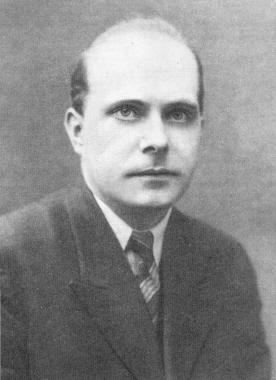
Gideon Ståhlberg
Morten Hansen provides English translations of passages from two books of Ståhlberg’s which discussed the display, the first being from page 119 of Strövtåg i schackvärlden (Skara, 1965):
‘Ordinary [i.e. non-blindfold] simultaneous exhibitions are a more effective and, in most cases for masters, a less exhausting form of chess propaganda. As regards the number of games, since 1942 [sic] I have held the unofficial world record. In Santos Lugares (a suburb of Buenos Aires) I played 400 games in 36 hours and five minutes. It naturally cannot be expected that hundreds of opponents should sit at a chessboard for more than 24 hours, and the organizers therefore limited to 40 the number of games played simultaneously. When a game was over I at once had a new opponent at the same table. Every four hours I could take a ten-minute break for refreshment, but I did not always make use of this.
Najdorf had previously, a year or so [sic] beforehand, played more than 220 games in Bahía Blanca, and I had promised the organizers that I would break the record. I had intended to raise it to 300, but since many chess enthusiasts had had no opportunity to play I went on and reached the good result of 362 games won, 24 lost and 14 drawn. The achievement had an effect on my strength, and it was several months before I was back to normal chess form.’
The second Swedish book from which Mr Hansen provides a translation is Schackspelarens läsebok (Stockholm, 1966), which Ståhlberg co-wrote with Åke Wassing. The following paragraph concerning Ståhlberg was on page 110:
‘Moreover, he holds a world record from his time in South America which will probably be hard for a future grandmaster to beat. It was a simultaneous match over no fewer than 400 games against qualified opposition which required 36 hours and five minutes to complete. He won 364 games, drew 14 and lost only 22. A truly fine achievement when it is considered that he did not sleep for 36 hours and that the opposition sent in 40 men at a time so that they could hold out.’
It will be noted that in these two books, published only a year or so apart, different results were given. An unclear point is why Ståhlberg referred to a promise to break Najdorf’s record if the two displays were structured altogether differently.
Christian Sánchez has found the following report (translated here by us) on page 16 of the newspaper La Prensa, 2 September 1941:
‘Simultaneous exhibition by the master Ståhlberg
In Santos Lugares an interesting chess exhibition has taken place, consisting of a session of simultaneous games conducted by the Swedish chessplayer Gideon Ståhlberg.
As has already been the case on other occasions in our country, the master began his performance by confronting a limited number of boards, and as the games were concluded the opponents were replaced, this procedure being continued until 400 games had been completed. Ståhlberg won 362 games, drew 16 and lost 22, taking a total of 36 hours, during which time he had various rest periods.
At the request of the organizers, the Argentine Chess Federation appointed a representative to supervise the contest, even though the event cannot be recognized as a record of any kind and can be considered only a great physical effort and a curious exhibition.’
There are additional complications to be considered now, arising from the following paragraph on page 232 of the July 1948 CHESS:
‘On the occasion of the 25th anniversary of the Velberter Schachgesellschaft, the ex-Viennese master, Hönlinger, broke the world’s record for simultaneous chess set up by Najdorf. Playing on 5 May of this year, he met 213 opponents and, playing for 12 hours 28 minutes without a break, won 187, drew 13 and lost 13. The event was mentioned on the radio, and hundreds of spectators attended throughout.’
Further brief items discussed this exploit in the issues of August (page 252), September (page 269), November (page 40) and December (page 63), although nobody raised the question of how 213 opponents could be a record if the report in El Ajedrez Americano (C.N. 3375) was correct, i.e. that Najdorf had faced 222 players.
One CHESS reader stated that Hönlinger’s performance was not a record given that Ståhlberg had played 400 games simultaneously, in reply to which a German correspondent asserted that Hönlinger had played for 12½ hours without a break, whereas Ståhlberg had an interval with one night’s sleep. Writing from Surte (Sweden) on 13 October 1948 Ståhlberg then gave the following account on page 63 of the December 1948 CHESS:
‘… I want you to know how I played those 700 [sic – 400 was evidently meant] games seven years ago. I played about 40 games at the same time; when a game was finished, a new opponent turns up to try his luck, and so on. In fact, I believe this to be more difficult for the master than if he has to play all the games at the same time, because his opponents don’t get so tired. I had only five to ten minutes to get some food every three or four hours, and of course I didn’t sleep one night during the exhibition, as a German correspondent claims. As a matter of fact, I didn’t even sleep the night after the exhibition, but played roulette to six o’clock in the morning.’
Without discounting the possibility of further discoveries about Ståhlberg’s display (not one game-score has yet been found), we feel that the spotlight should now be trained on Najdorf’s exhibition in Bahía Blanca in 1941. Did he really play 222 games simultaneously?
(3383)
From Christian Sánchez:
‘I have found a couple of reports from another newspaper giving a different account of the display. According to La Nación, Ståhlberg was intending to achieve a time record, i.e. to play chess for 48 hours. However, he became exhausted, and the contest was suspended after 36 hours. It is understandable that subsequent accounts did not mention that the original attempt had failed, stressing instead the number of games played.’
Below are the two texts (which misspelt the Swedish master’s name). The first comes from La Nación, 31 August 1941, page 15:
‘INSTITUCIÓN SARMIENTO, DE SANTOS LUGARES
Una original prueba de resistencia está realizando el ajedrecista Gedeón Stalberg en el Club Institución Sarmiento, de Santos Lugares, pues se propone jugar durante 48 horas consecutivas con 30 adversarios simultáneamente, como máximo, y 10, como mínimo, Al finalizar 23 horas de juego el citado maestro había realizado 276 partidas con este resultado: 254 ganadas, 13 perdidas y 9 tablas. La prueba finalizará hoy a las 24.’
The second report appeared in La Nación, 1 September 1941, page 20:
‘INSTITUCIÓN SARMIENTO, DE SANTOS LUGARES
Finalizó ayer a las 10 la prueba de resistencia ajedrecística que el jugador Gedeón Stalberg se propuso llevar a efecto durante 48 horas en el Club Institución Sarmiento, de Santos Lugares.
Luego de cumplir 400 partidas, el citado maestro fue sintiendo gran agotamiento físico, que lo imposibilitaba para continuar actuando. En vista de tales circunstancias, Stalberg solicitó la suspensión de la prueba cuando habían transcurrido 36 horas de juego continuado. Ganó 362 partidas, 16 hizo tablas y perdió 22.’
(3399)
Searching for more information about the claims that Najdorf established a world record for simultaneous play in Bahía Blanca in the early 1940s, we have found a report in the May 1941 issue of the Argentinian magazine Enroque!! (ninth and tenth pages, but unnumbered). This states that on 19 April of that year (beginning at 14.30) Najdorf played 222 games at one and the same time and that when the séance ended (at about four o’clock the following morning) Najdorf had scored +202 –8 =12. Enroque!! also reported that the display was duly ratified by FIDE, via the Argentine Chess Federation, and gave one game:
Miguel Najdorf – Rodolfo M. Bentivoglio1 e4 e6 2 d4 d5 3 Nc3 Bb4 4 e5 c5 5 a3 cxd4 6 axb4 dxc3 7 bxc3 Qc7 8 Nf3 Qxc3+ 9 Bd2 Qc7 10 Bd3 Nc6 11 Qe2 b6 12 O-O Nge7 13 b5 Nd8 14 Bb4 Nb7 15 Nd4 Nc5 16 f4 Bd7 17 f5 g6 18 fxe6 Nxe6 19 Nxe6 Bxe6 20 Bd6 Qd7 21 c4 Rc8 22 cxd5 Bxd5 23 Be4 Bxe4 24 Qxe4 O-O 25 Qa4 Ra8 26 Qb4 Rfe8 27 Rad1 Qb7 28 Qc4 Nf5
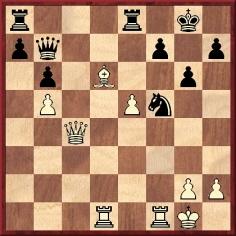
29 Rxf5 gxf5 30 Qf4 Re6 31 Qxf5 Rg6 32 Rd2 Rc8 33 h4 Rc1+ 34 Kh2 Qc8 35 Qf2 Qe6 36 h5 Rg5 37 Qf3 h6 38 Rf2 Rc4 39 g3 Rcg4 40 Qa8+ Kh7 41 Qf8 Rxh5+ 42 Kg2 Rf5 43 White resigns. The magazine pointed out that 42...Rxg3+ would have been a quicker finish.
(3419)
Christian Sánchez writes:
‘The reports in the newspapers La Nación and La Prensa of Buenos Aires and La Capital of Rosario broadly agree with the magazine Enroque!! regarding Najdorf’s record, as given in C.N. 3419. The display was held at the Club Atlético Olimpo of Bahía Blanca and attracted 5,000 spectators. It began at 14.30 and ended at 04.00 the next day. However, the reports indicate irrefutably that the day the exhibition began was 1 May 1941. That Enroque!! put 19 April is doubtless an error resulting from the similarity between “19” and “1º” (the latter meaning “first” in Spanish).’
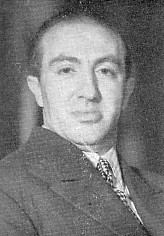
Miguel Najdorf
Our correspondent has kindly submitted transcriptions of the following reports:
(3436)
As noted in C.N. 3375, page 33 of the February 1931 American Chess Bulletin referred to an exploit in simultaneous chess by István Abonyi (1886-1942). We now note that some details were given on page 45 of the February 1928 Wiener Schachzeitung and page 107 of the April 1928 issue. In Budapest on 21-22 January 1928 (from 19.00 to approximately 06.00, without a break) Abonyi faced 300 consulting opponents on 105 boards, scoring +79 –6 =20.
(3907)
Bernd Graefrath (Mülheim an der Ruhr, Germany) writes:
‘In C.N. 3383 you referred to a simultaneous exhibition by Hönlinger in Velbert in 1948. I have received from the Stadtarchiv in Velbert a copy of the report (entitled “Weltrekord gebrochen”) published in the local newspaper Rhein-Echo of 15 May 1948. Here is the complete text:
“Velbert. Als Auftakt zur Feier des 25jährigen Bestehens der Velberter Schachgesellschaft unternahm der frühere Wiener Meister Hönlinger einen erfolgreichen Angriff auf den Weltrekord im Simultanspiel. Hönlinger spielte zwölfeinhalb Stunden lang ununterbrochen gegen 213 der stärksten Spieler aus Westfalen und vom Niederrhein. Es gelang ihm, 187 Gegner matt zu setzen oder zur Aufgabe zu zwingen. Nur 13 Partien gingen für ihn verloren, während weitere 13 unentschieden endeten. Der bisherige Weltrekord wurde von dem Argentinier Najdorf – mit 184 Punkten aus 202 Partien - gehalten. Hönlinger erreichte 193½ Punkte. Um die internationale Anerkennung des in Velbert aufgestellten neuen Weltrekordes – von dem der Nordwestdeutsche Rundfunk aus dem ‘Rheinischen Hof’ in seinem ‘Westdeutschen Tagebuch’ berichtete – ist bereits nachgesucht.”
This report on Hönlinger’s display (+187 –13 =13) raises several questions. Had Najdorf previously played only 202 games, whereas other accounts mentioned in C.N. referred to 222 games by him? Did the world record concern the total number of games or (also) the number of points scored? Did Hönlinger play all 213 games simultaneously? And where could one apply (or, at least, appeal to) for official recognition of a world record?’
Below is a photograph of Hönlinger during his display, from page 252 of the August 1948 CHESS:
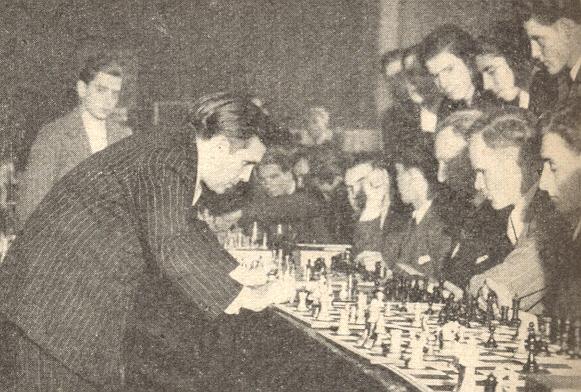
(4571)
For a discussion of more recent displays (by G.J. Martin, A. Martin and S. Polgar) see C.N.s 4800, 5025 and 5028.
Above there is a reference to Ossip Bernstein, and further details are added now. On page 8 of his monograph on Bernstein, Moderne Schachstrategie (Breslau, 1930), Tartakower wrote:
‘Bekanntlich war Dr Bernstein von jeher einer der besten und schnellsten Simultanspieler, da er bereits im Jahre 1903 in Berlin mit 80 innerhalb von 5½ Stunden durchgeführten Simultanpartien (Resultat. +70 –4 =6) eine Rekordleistung vollbrachte.’
The correct year would appear to be 1904, a different set of details being given on page 91 of the March 1904 Deutsche Schachzeitung:

(6965)
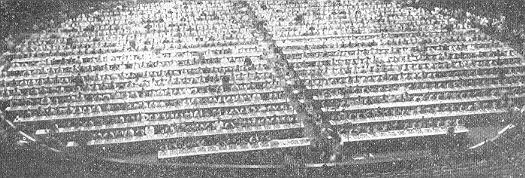
After the above ‘mystery photograph’ was shown in C.N. 3993, a number of readers replied that it depicted a large simultaneous display during the 1966 Olympiad in Havana, but we had rolled out some tripwire.
It is true, as one correspondent recalled, that a Cuban postage stamp commemorating the Olympiad had a similar illustration:
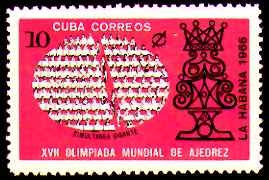
Pages 465 and 466-467 of the Cuban book on the Olympiad, Cuba/66 XVII olimpíada mundial de ajedrez, included two photographs of the ‘simultánea gigante’ in Havana during the team competition:
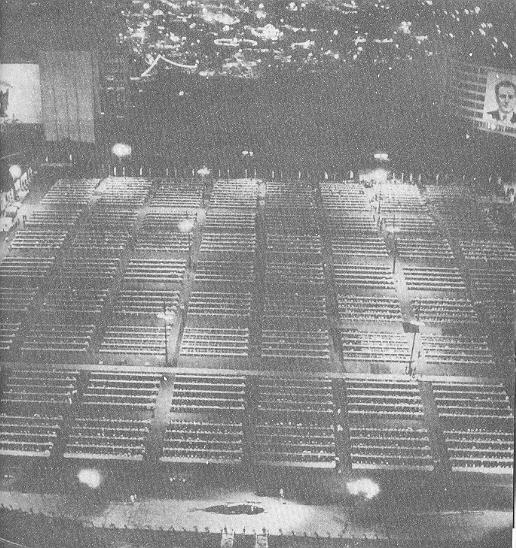
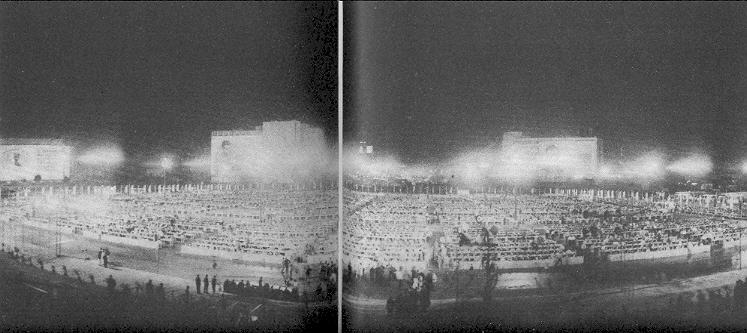
Moreover, the same book (page 40) had, as another correspondent remarked, the picture below, from the fourth Capablanca in Memoriam tournament, i.e. in 1965:
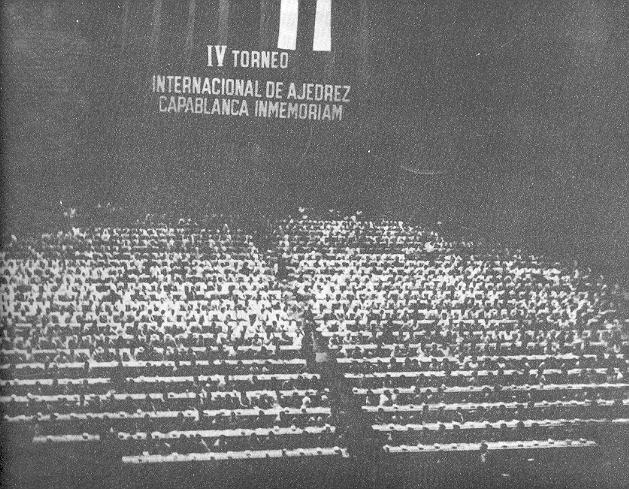
However, the mystery photograph in C.N. 3993 had been published in CHESS two years previously (on page 226 of the 6 May 1963 issue). The caption read:
‘A picture from Havana of the world record simultaneous display on 13 March, in which 40 of Cuba’s leading players, led by the national champion Eleazar Jiménez, tackled one thousand two hundred opponents at the same time.’
This 1963 event was also mentioned on page 41 of the above Cuban book, where the date was given as 12 March and it was stated that 40 masters took on 1,241 opponents.
(3996)
To the Chess Notes main page.
To the Archives for other feature articles.
Copyright: Edward Winter. All rights reserved.